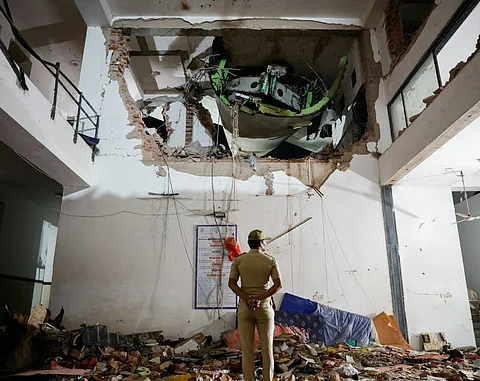

Air India’s fatal crash involving a Boeing 787 Dreamliner has dealt a serious blow to the airline’s comeback efforts under the Tata Group’s ownership, analysts say. The London-bound aircraft, carrying 242 people, went down moments after take-off from Ahmedabad on Thursday, killing all but one on board.
The plane, which crashed into a residential area and exploded into a fireball, has raised pressing questions about what went wrong with the modern, fuel-efficient jetliner—considered one of the safest in service.
“This is a fifth-generation aircraft and seeing such a catastrophic crash is deeply troubling,” said Mark D Martin, CEO of aviation consultancy Martin Consulting. “It seems the pilot had no thrust available and was unable to sustain the climb. That’s a technical issue, but it also raises broader concerns about operational oversight.”
The crash is the first fatal incident involving a 787-8 Dreamliner, which entered commercial service in 2011. The aircraft was delivered to Air India in 2014, Flightradar24 data showed.
“It’s shocking this happened despite experienced crew and proper maintenance,” said Martin. “You can no longer blame the government for mismanagement—Air India has been in private hands since 2022.”
Air India, founded by JRD Tata in the 1930s and nationalised in the 1950s, has been undergoing an ambitious revival since its return to Tata Group control. Under CEO Campbell Wilson, a seasoned aviation executive and former chief of Singapore’s Scoot, the airline has launched a sweeping fleet renewal and service overhaul.
Last year, Air India placed one of the world’s largest aircraft orders—470 planes from Airbus and Boeing. That was followed by another order for 100 Airbus aircraft. However, Thursday’s disaster is likely to stall those plans, experts warn.
“This will undoubtedly affect the brand and slow the pace of its rehabilitation,” said Shukor Yusof, analyst and founder of Malaysia-based Endau Analytics. “Recent issues with onboard behaviour, service quality, and now this crash will erode passenger trust.”
Restoring confidence, Yusof added, would require transparency and empathy. “Be open with facts, speak with one voice, and show compassion for affected families.”
Shantanu Gangakhedkar, senior consultant at Frost & Sullivan, said the airline must conduct an open investigation and release the findings publicly. “Only then can people begin to understand what really happened,” he said.
He noted the damage to Air India’s revival plans would depend on the nature of the failure—technical, human, or maintenance-related—and how the airline manages the fallout.
India’s aviation industry has largely maintained a strong safety record in recent years. The last fatal incident was in 2020, when an Air India Express flight skidded off the runway in Kozhikode, killing 21 people. One of the country’s worst disasters was the 1996 mid-air collision between Saudi and Kazakh aircraft near Charkhi Dadri, killing 349 people.
“There hasn’t been an accident of this magnitude in years,” said Rajeev Kohli, joint managing director of Creative Travel. “We must wait for the investigation before drawing conclusions.”
Despite progress in aviation safety, India has seen tragedies before, such as the 2010 Mangalore crash that killed 158 people. Thursday’s accident adds a grim chapter to that history—and presents a major challenge to Air India’s efforts to reclaim its place as a world-class airline.